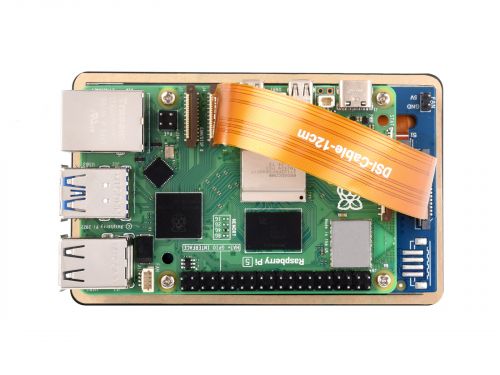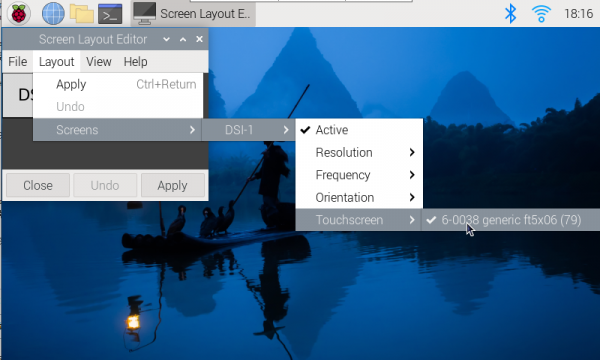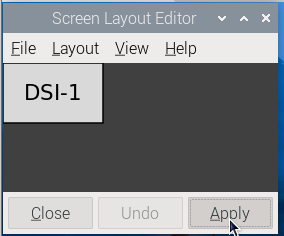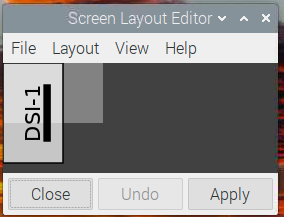Difference between revisions of "4inch DSI LCD"
m (Text replacement - "=='''Support'''==" to "") |
|||
| (One intermediate revision by the same user not shown) | |||
| Line 2: | Line 2: | ||
{{Infobox item | {{Infobox item | ||
|img=<div class="tabber"><div class="tabbertab" title="Standard Version"> | |img=<div class="tabber"><div class="tabbertab" title="Standard Version"> | ||
| − | [[File:4inch-DSI-LCD.jpg|300px | + | [[File:4inch-DSI-LCD.jpg|300px|{{Amazon_nolink|default={{#urlget:amazon|0}}|{#urlget:Amazon|0}}|default|}}|ur1=link=https://www.waveshare.com/4inch-dsi-lcd.htm?amazon}}]]</div> |
</div> | </div> | ||
| Line 40: | Line 40: | ||
</pre> | </pre> | ||
Choose Advanced Options -> Glamor -> Yes(Enabled) -> OK -> Finish -> Yes(Reboot) | Choose Advanced Options -> Glamor -> Yes(Enabled) -> OK -> Finish -> Yes(Reboot) | ||
| + | }} | ||
| + | {{FAQ|How to replace the Raspberry Pi startup logo image? | ||
| + | |Replace the custom image with the image in /usr/share/plymouth/themes/pix/splash.png. | ||
}} | }} | ||
Revision as of 01:56, 29 June 2022
| ||
Introduction
Features
- 4-inch DSI touch screen with 5-point capacitive touch control.
- IPS display panel with a hardware resolution of 480 × 800.
- Adopts optical bonding tech, so the picture is clearer.
- Toughened glass capacitive touch panel, hardness up to 6H.
- Support Pi5/4B/CM4/3B+/3A+/3B/CM3+/CM3.
- Drive LCD directly through Raspberry Pi's DSI interface with a refresh rate of up to 60Hz.
- Working with Raspberry Pi, supports Bookworm/Bullseye/Buster.
- Support backlight adjusted by software.
Hardware connection
Working with Pi4B/3B+/3B/3A+
Use a 15PIN FPC cable to connect the 4inch DSI LCD to the DSI interface of the Raspberry Pi.

Working with Pi5/CM4/CM3+/CM3
Use the "DSI-Cable-12cm" ribbon cable to connect the LCD screen's DSI interface to the Raspberry Pi's 22PIN DSI1 interface.
The installation effect as shown below:

Software settings
For Bookworm and Bullseye System
- 1. Insert the TF card into the PC, download it, and use Raspberry Pi Imager to program the corresponding image.
- 2. After programming the image, open the "config.txt" file located in the root directory of the TF card. Add the following code at the end of config.txt, save the file, and safely eject the TF card.
Note: As Pi 5/CM4/CM3+/CM3 has two MIPI DSI interfaces, please ensure to use the correct DSI interface and command. DSI1 is recommended by default.
dtoverlay=vc4-kms-v3d #DSI1 Use dtoverlay=vc4-kms-dsi-waveshare-panel,4_0_inch #DSI0 Use #dtoverlay=vc4-kms-dsi-waveshare-panel,4_0_inch,dsi0
- 3. Insert the TF card into the Raspberry Pi, power on the Raspberry Pi, and wait for a few seconds. After the system boots up, you should be able to enter the display interface and the LCD should touch normally.
For Buster System
Method 1: Install Manually
1) Download the image from the Raspberry Pi website.
2) Connect the TF card to the PC, and use SDFormatter software to format the TF card.
3) Open the Win32DiskImager software, select the system image downloaded in step 2, and click "write" to write the system image.
4) After the image has finished writing, save, and quit the TF card safely.
5) Connect the TF card to the Raspberry Pi, start the Raspberry Pi, and log in to the terminal of the Raspberry Pi (you can connect the Raspberry Pi to an HDMI display or log in remotely with ssh).
#Step 1: Download and enter the Waveshare-DSI-LCD driver folder git clone https://github.com/waveshare/Waveshare-DSI-LCD cd Waveshare-DSI-LCD #Step 2: Enter uname --all in the terminal to view the kernel version, and cd to the corresponding file directory #5.15.61 then run the following command cd 5.15.61 #Step 3: Please check the bits of your system, enter the 32 directory for 32-bit systems, and enter the 64 directory for 64-bit systems cd 32 #cd 64 #Step 4: Enter your corresponding model command to install the driver, pay attention to the selection of the I2C DIP switch #4inch DSI LCD 480×800 Driver: sudo bash ./WS_xinchDSI_MAIN.sh 40 I2C0 #Step 5: Wait for a few seconds, when the driver installation is complete and no error is prompted, restart and load the DSI driver and it can be used normally sudo reboot #Note: The above steps need to ensure that the Raspberry Pi can connect to the Internet normally.
Note: The above steps need to ensure that the Raspberry Pi can be connected to the Internet normally.
6) Wait for the system to restart, it will be able to display and touch normally.
Method 2: Program Pre-install Image
1. Select your corresponding Raspberry Pi version image, download and decompress it as ".img" file.
Raspberry Pi 4B/CM4 version download: Waveshare DSI LCD - Pi4 pre-install image
Raspberry Pi 3B/3B+/CM3 version download: Waveshare DSI LCD - Pi3 pre-install image
2. Connect the TF card to the PC and use SDFormatter to format the TF card.
3. Open Win32DiskImager software, choose the system image prepared in the first step, and then click "write" to write the system image.
4. After the programming is finished, open the config.txt file in the root directory of the TF card, add the following code under [all], save and eject the TF card safely.
dtoverlay=WS_xinchDSI_Screen,SCREEN_type=1,I2C_bus=10 dtoverlay=WS_xinchDSI_Touch,invertedx,swappedxy,I2C_bus=10
5. Connect the TF card to the Raspberry Pi, and start the Raspberry Pi, wait for about 30 seconds to display and touch normally.
Buster System Notices
1. Update the system and run the following commands:
sudo apt-get update sudo apt-get full-upgrade
Note: After updating the system, some diver files installed before may be covered, and you need to install the driver again so that it can display normally.
2. Replace the main board.
If the driver installed was for the Raspberry Pi 4 Model B and the user decides to change the mainboard, for example, to the Raspberry Pi 3 Model B+, it may result in the display screen not showing properly.
This is because the Pi 4 and Pi 3 require loading different driver files. To ensure proper display functionality on the new mainboard, the user needs to reinstall the drivers according to the instructions #For Buster System.
Backlight Control
WaveShare provides the corresponding demo for the application (only supports Bookworm and Bullseye systems). Users can install it by the following commands:
wget https://files.waveshare.com/upload/f/f4/Brightness.zip unzip Brightness.zip cd Brightness sudo chmod +x install.sh ./install.sh
After installation, you can open it: Menu -》Accessories -》Brightness:
In addition, you can also input the following commands to control the backlight brightness:
echo X | sudo tee /sys/class/backlight/*/brightness
Where X indicates any number from 0 to 255. 0 means the backlight is the darkest, and 255 means the backlight is the brightest. For example:
echo 100 | sudo tee /sys/class/backlight/*/brightness echo 0 | sudo tee /sys/class/backlight/*/brightness echo 255 | sudo tee /sys/class/backlight/*/brightness
Sleep Mode
Run the following commands on the Raspberry Pi, and the screen can enter the sleep mode:
xset dpms force off
Bookworm Touchscreen Rotation
- 1. Open "Screen Configuration" application:
- 2. Enter "Screen" -> "DS-1" -> "Touchscreen", and select "6-0038 generic ft5x06(79)".
- 3. Click "Apply", and then close the current window. Reboot according to the pop-up prompts to complete the specified touchscreen;
- 4. Enter "Screen" -> "DS-1"->"Orientation", and select the rotation direction. Then click on "Apply".

Note: Only the Bookworm system supports the above-synchronized rotation method, for Bullseye and Butser systems, after displaying the rotation, you need to set the touch rotation additionally.
Bullseye/Buster Display Rotation
- 1. Open "Screen Configuration" application:
- 2. Enter "Screen"->"DS-1"->"Orientation", select the rotation direction, and then click on "Apply".
Bullseye/Buster Touch Rotation
sudo nano /boot/config.txt #Change the command for the touch rotation angle at the end of the config.txt file, reboot it to take effect (the command for 0° touch direction exists by default) #90°: dtoverlay=WS_xinchDSI_Touch,invertedx,invertedy #180°: dtoverlay=WS_xinchDSI_Touch,invertedy,swappedxy #270°: dtoverlay=WS_xinchDSI_Touch #0°: dtoverlay=WS_xinchDSI_Touch,invertedx,swappedxy
lite Version Rotation
sudo nano /boot/cmdline.txt #Add the command to display the rotation angle at the beginning of the cmdline.txt file, save and reboot to take effect #Display rotates 90° video=DSI-1:480x800M@60,rotate=90 #Display rotates 180° video=DSI-1:480x800M@60,rotate=180 #Display rotates 270° video=DSI-1:480x800M@60,rotate=270
Disable Touching
At the end of the config.txt file, add the following commands corresponding to disabling touch (the config file is located in the root directory of the TF card, and can also be accessed through the command: sudo nano /boot/config.txt):
disable_touchscreen=1
Note: After adding the command, it needs to be restarted to take effect.
FAQ
sudo raspi-config
Choose Advanced Options -> Glamor -> Yes(Enabled) -> OK -> Finish -> Yes(Reboot)
{{{5}}}
{{{5}}}
Anti-Piracy
Since the first-generation Raspberry Pi released, Waveshare has been working on designing, developing, and producing various fantastic touch LCDs for the Pi. Unfortunately, there are quite a few pirated/knock-off products in the market. They're usually some poor copies of our early hardware revisions, and comes with none support service.
To avoid becoming a victim of pirated products, please pay attention to the following features when purchasing:
Beware of knock-offs
Please note that we've found some poor copies of this item in the market. They are usually made of inferior materials and shipped without any testing.
You might be wondering if the one you're watching or you've purchased in other non-official stores is original, feel free to contact us.









